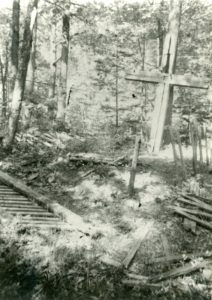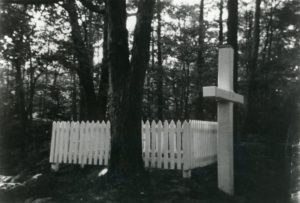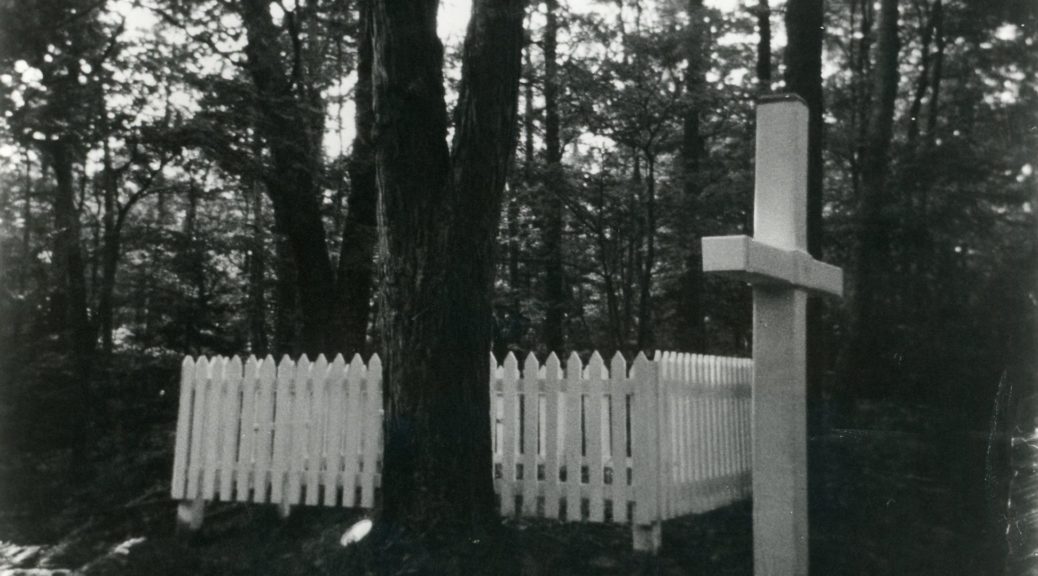This story was passed on to Lloyd “Allie” Westcott by his grandmother, Mrs. Charles (or John) Fisher. The recorder was Roy H. Steffens, a local historian operating largely in the 1960s and 1970s, known especially for his interest in Civil War and Spanish American War soldiers and grave sites. A manuscript copy of this story was found among Steffens’ papers in the Local History Collection at Traverse Area District Library. Steffens and Westcott restored the cross and fence described later in this story, in 1968.

The lake was fairly calm that day and a couple men from the settlement of Glen Arbor were down by the lake when they noticed this small rowboat with a white sheet for a makeshift sail not far out from the shore. Word got back to the settlement of this boat with two people aboard. In a short time most of the people from the settlement gathered at the beach to welcome some strangers or newcomers to their settlement.
It was discovered that there was two people aboard the small boat, a man and a woman. There seemed to be some reluctance on the part of the couple aboard the boat to communicate with the people on shore or land their boat, not knowing where they were or if the people were friendly. It was known by the couple in the boat that there was animosity among the people on mainland and those that were from King Strang’s cult.
However in due time thru conversation the barrier of fear soon was overcome and the boat landed. The couple made themselves known as Mr. and Mrs. Fields and they had come from Beaver Island. They had explained they escaped from the island in the darkness of night as they wanted to get away from the tyranny that King Strand held over his people. They asked that they may stay a short while to rest up from their tedious trip as they wanted to get passage on steamer (propeller) that plied the Lakes to Chicago or some other port.
The men helped to unload their meager belongings from the boat and all proceeded to the settlement. The Fields knew of the consequences they might suffer from the hands of King Strang’s ruthless men should they be found. It was decided to push the empty boat out in the lake to drift so if found it might be presumed that those in it had drowned or met with some other misfortune.
After unloading the boat all the people along with Mr. and Mrs. Fields proceeded up to the settlement. The local people realizing their plight vowed they would not reveal their names, their whereabouts or that they had been there. A John Dorsey that had a sailboat he used to bring in supplies from Frankfort agreed that when the Fields were ready he would take them to South Manitou Island where they might get passage on a steamer that would stop there. South Manitou was a port of call for the steamers to load up with cord wood which was used for fuel.

It was imminent that Mrs. Fields was about to give birth to a child and her time would be shortcoming. The women of the settlement prevailed up on them that they should stay with them until after the child was born. In a short time her time came and she gave birth to twins. Sadly enough though she should die from childbirth as well as the two babies.
Mr. Fields secured some lumber and constructed a coffin in which was placed his wife with a child in each arm. A grave was dug on the small hill in which the coffin was placed. The people of the settlement all gathered for this sad event and she was given a Christian burial.

Mr. Fields constructed a large wooden cross out of cedar which he placed on the hill. The large cross thru time had weathered badly and became broken. He also made a picket fence to surround the grave which weathered away due to time. A not of interest is that the picket fence was put together with iron cut nails. Also he placed at the head of the grave a smaller beautifully carved cross.
After completing his work Mr. Fields sought passage on a steamer to leave and never returned as far as anyone knows.

The grave marker and picket fence described in this tale are found in Fisher Cemetery, Glen Arbor, Michigan. As James Strang ruled on Beaver Island from late 1850 until his murder in 1856, for this story to have any veracity, it must have taken place during these years, dating the graves of Mrs. Fields and her children to about the same time. This very dramatic story is widely known and repeated, but little corroborating evidence has ever come to light. Richard Fidler, editor of Grand Traverse Journal, published this piece way back in November 2015, concerning the Strang murder.


I have a photograph of Mr. and Mrs. Fields taken with Tip Miller, George Miller, Ruth Miller Bedford, and Bridget Harkins Miller. There is no date on the photo but the frame advertises the photographer to be from Frankfort. This was probably taken when Tip and Bridget were tending the Pointe Betsie Life Saving Station. Which was well after Ruth’s husband assisted in the asassination of Strang. Mrs. Fields is looking fit and trim,
of course…. could be a second Mrs. Fields….
Wow, neat, Theresa! We would love to see that image sometime. As I mentioned in the notes at the end, there’s not be a lot of corroborating evidence to verify the Fields story, so your photo might be a real clue!
The tale of Mrs. Fields was printed in a book by Al Barnes– no idea what/who his source was, perhaps Roy Steffens but not sure how accurate it is. I did some research on this 11 years ago and came across someone whose ancestors were a Field family who followed Strang from Wisc. to Beaver Island at this time– The story that came down thru their family is different. It was basically this– They believe that Mrs. Rhoda Field left B. Island because she did not want to stay with her husband who had taken another wife. It is believed she came to G. Arbor accompanied by a brother-in-law or other family member but died there after a short time. They’re not sure it was in childbirth or not. This would have occurred between 1850-1860– Rhoda is not listed with the family in the 1860 census–they are on Beaver Island in 1850. The likelihood that the photo is the same Field family is slim– probably not much photography was done in this isolated region between ’50-’60. The husband and other B. Island family members later located in mid-Michigan- Montcalm Co. The other person buried in this little “cemetery” is John Tilton. Mr. Steffens did great research but the man he lists is a different John Tilton who was from Coldwater and never lived here. This John M. Tilton died mysteriously (I haven’t found anything about it even after over 10 years of searching!) between Nov. 1863 when he was drafted to serve in the Civil War and- May 1866. He was a whaleboat sailor, originally from Bristol, MA. He and his wife Lydia came to Glen Arbor around 1862. Two of their 4 children were born here. He had a brother James Tilton who lived near Oviatt until about 1890 when he returned to Mass.
Whoa! Julie, we should always confirm with you before publishing anything. You’re such a wealth of knowledge! Thank you for adding to this story!